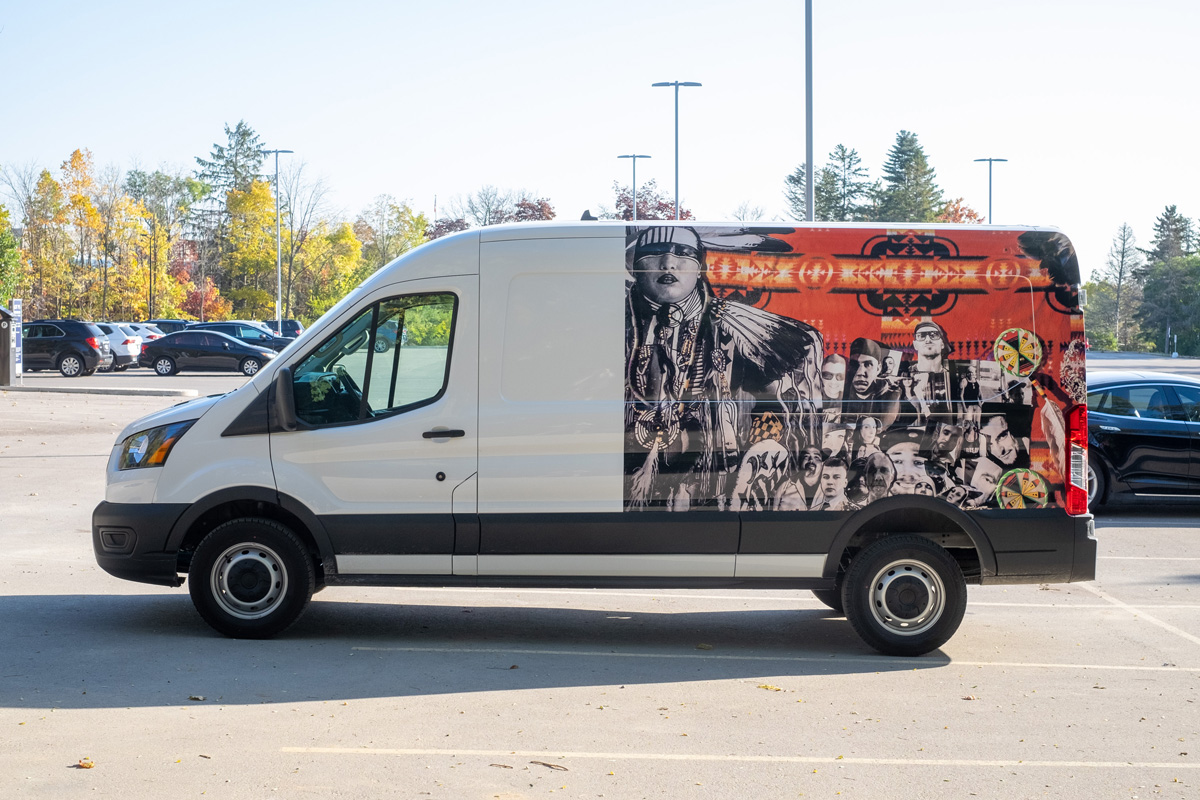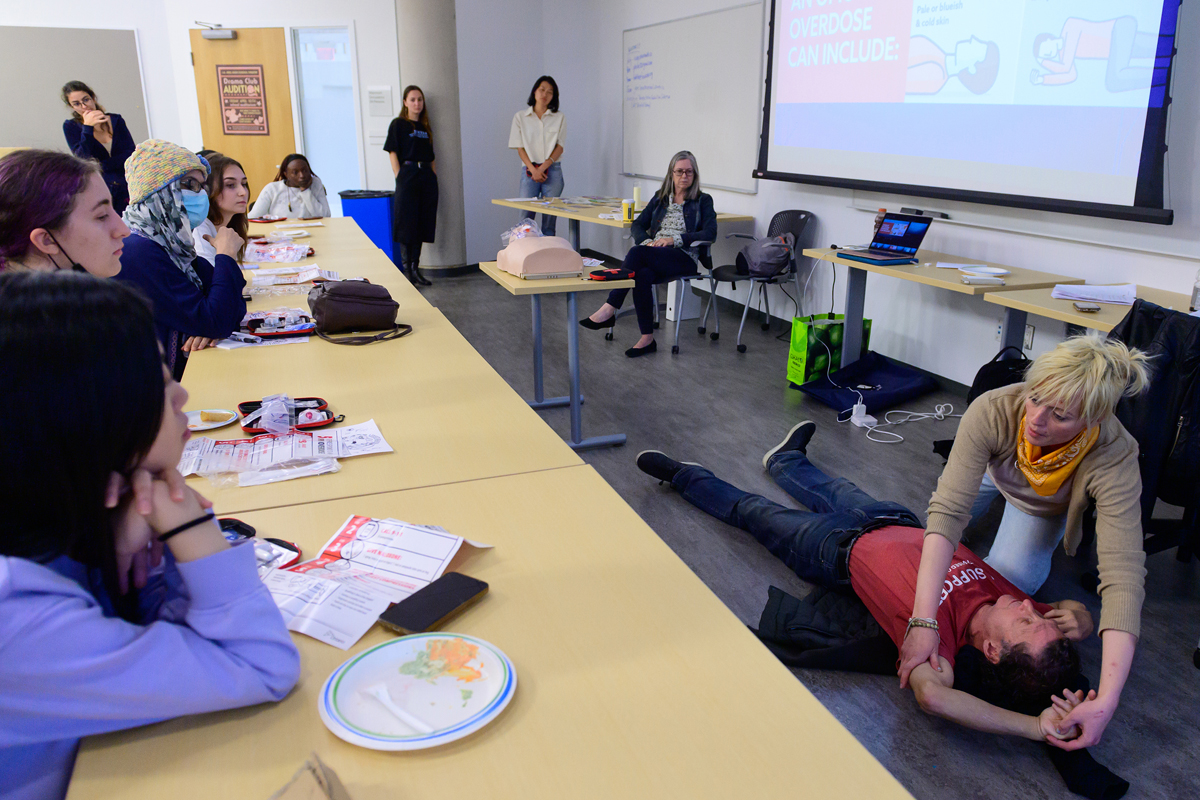The JHI Program for the Arts aims to enhance, improve, and raise the profile of the Arts at the University of Toronto by supporting a variety of events, both small and large. As applications open for 2023-2024, we revisit one of this year’s events—"Wish You Were Here, Wish Here Was Better" with Ellyn Walker, former Acting Director of the Blackwood Gallery at UTM and one of the creative forces behind the project, which ran from October 3 to 9, 2022.
Walker’s concept for "Wish You Were Here, Wish Here Was Better" was to create a mobile installation that would connect with students, staff, faculty, and visitors across the UTM campus and Peel Region communities, and to provide space for those affected by the ongoing overdose crisis. Walker, collaborators Zoë Dodd and Theodore (ted) Kerr, as well as the team at the Blackwood Gallery, developed a seven-day project featuring public events, talks, workshops, and pop-ups that concluded with a Community Feast for the Spirits. The team worked closely with community partners to ensure that the project reflected the needs and experiences of those impacted by the overdose crisis, resulting in a successful and meaningful project met with enthusiasm and appreciation.
JHI: How did Wish You Were Here, Wish Here Was Better come about?
EW: This project came from a dream I had about a roving artwork that would allow the Blackwood Gallery at the University of Toronto Mississauga to continue to connect with diverse students, staff, faculty, and visitors across the UTM campus and into our surrounding Peel communities.
To bring that dream to reality, I worked with two primary collaborators: community organizer and scholar Zoë Dodd, and writer Theodore (ted) Kerr. Together with the Blackwood Gallery team, we developed this project around a central, mobile cargo van that was wrapped with artwork by Les Harper, and that popped up at sites in Mississauga and Brampton over the course of seven days in October 2022. The project created space for grief, solidarity, and mobilization amongst people impacted by the ongoing overdose crisis and its related systemic affects, including precarity, houselessness, and criminalization. To do that, we held public events, such as talks and workshops, recurring pop-ups on UTM campus, and closed events geared at members of the public served by our community partners. The project gathered momentum throughout the week, and culminated in a Community Feast for the Spirits with dancers, singers, and a healing circle, where participants shared reflections and remembrances.
JHI: Can you talk about the importance of community outreach, collaboration and engagement?
EW: This project would not have been possible without significant community input and partnerships, new and existing to the Blackwood. Partners shared insights about how their communities have been affected by the overdose crisis, and how this project might support and uplift their work. As a result, their feedback strengthened what we could offer, which in many cases was an open-ended and empathetic space for people to mourn and to reflect on the overdose crisis.
The artwork Les Harper created for the mobile van hinged on outreach as well: in consultation with a network of people who use drugs, his mural commemorated people in Peel Region who have been lost to the overdose crisis since the start of Covid-19. His artwork helped to show that these people aren’t forgotten, and we can honour their memory by advocating for a safe drug supply, amongst other things.
JHI: What did you hope your participants would take away from Wish You Were Here, Wish Here Was Better ?
EW: The hope was that people would feel connection, curiosity, and respect. We wanted to listen to those who wanted to share, while also offering information to those who wanted to learn more. We provided a range of material take-aways—food, refreshments, votive candles, fresh flowers, artist postcards and projects, activist newsletters and zines, and Polaroids—and an open-ended poetry exercise offered visitors and participants a medium in which to question drug policy, share their experiences, and imagine alternative futures rooted in care and harm reduction. Despite the project’s short timeline, we were able to offer a caring and supportive space where participants could linger with any grief they might be holding.
JHI: How were the events received by the attendees and the wider community?
EW: We were fortunate to be met with enthusiasm and appreciation. For many of the most marginalized people we engaged with, a large part of their interactions with institutions are service-oriented. By contrast, this project only asked of them what they chose to bring to it, and it created encounters with art that might not happen otherwise.
On campus, we had many positive interactions as well; UTM students were particularly drawn to the Overdose Response Workshop we held, which offered Naloxone training to a full-capacity group.
JHI: Can you share any feedback from attendees of the events?
EW: We learned from our interactions on UTM's campus that many students know someone or are directly affected by the overdose crisis. This was astounding information to hear from students of all walks of life, as it made clear the generational shift that has happened in terms of toxic, tainted drugs. For attendees who came of age before the rise of street fentanyl, the urgency and immediacy of the overdose crisis might be overlooked. Together, attendees and organizers learned many times over that the toxic drugs supply affects people from all facets of society.
Many attendees also expressed appreciation for the opportunity to collectively mourn and honour friends, families, and community members lost to the overdose crisis, which wasn’t previously possible due to COVID-19 restrictions and other forms of precarity.
JHI: How did you hear about the JHI's Program for the Arts and what made you apply? Can you say a few words about your experience for others thinking of applying to Program for the Arts?
EW: Do it! The JHI is a generous and rigorous support system for the arts and humanities and the Program for the Arts is committed to connecting scholarly and artistic research across the tri-campus. The JHI’s annual research themes continue to be a source of inspiration. This granting program has also been welcoming and flexible to different formats—as was the case in its support of the Blackwood’s 21-part podcast series Artists-in-Presidents: Transmissions to Power produced during the height of COVID-19.
“Wish You Were Here, Wish Here Was Better”, provided a space for individuals impacted by the ongoing overdose crisis to come together and connect through art. The emphasis on community outreach, collaboration, and engagement helped to create an inclusive and welcoming environment for participants. The range of material take-aways and activities offered during the project, from food and refreshments to Naloxone training, open-ended poetry exercises and a Community Feast for the Spirits, allowed attendees to engage on multiple levels. The success of the project highlights the power of the arts to facilitate healing and connection, and serves as an inspiration for future community-focussed artistic endeavours.
The JHI Program for the Arts is now accepting applications from appointed members of the tenured and teaching faculty at the University of Toronto for the 2023-2024 theme of Absence. The deadline to apply is March 21, 2023 at 4:00pm ET. You can find more information about the application process in our recent announcement.

WISH YOU WERE HERE, WISH HERE WAS BETTER van with artwork by Les Harper, 2022. Photo courtesy The Blackwood.

WISH YOU WERE HERE, WISH HERE WAS BETTER van with artwork by Les Harper, 2022. Photo courtesy The Blackwood.

URGENT ARCHIVES, October 5, 2022. Photo: Henry Chan.

URGENT ARCHIVES, October 5, 2022. Photo: Henry Chan.

Overdose Response Training, October 7, 2022. Photo: Henry Chan.

Community Feast for the Spirits, October 8, 2022. Photo: Noel Pandawa.

Community Feast for the Spirits, October 8, 2022. Photo: Noel Pandawa.


